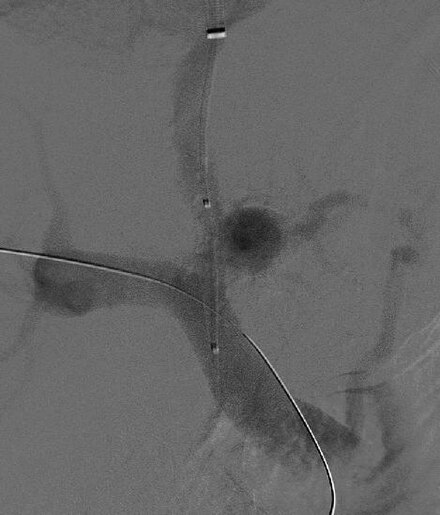Portal Hypertension
Portal hypertension is defined as an abnormally increased portal venous pressure, specifically when the hepatic venous pressure gradient exceeds 5 mmHg. Normal portal pressure ranges from 1–4 mmHg, while clinically significant portal hypertension is defined as portal pressures greater than 10 mmHg. This condition is most frequently caused by cirrhosis but can also arise from non-cirrhotic conditions.

Signs and Symptoms
Patients with portal hypertension often present with abdominal swelling due to ascites, vomiting blood, and laboratory abnormalities like elevated liver enzymes and low platelet counts. Specific signs and symptoms include:
- Abdominal swelling and tightness due to ascites.
- Vomiting blood (haematemesis) from gastric or oesophageal varices.
- Anorectal varices.
- Increased spleen size (splenomegaly), which may lead to thrombocytopenia.
- Swollen veins on the anterior abdominal wall, known as caput medusae.
Causes
The causes of portal hypertension are categorised into prehepatic, intrahepatic, and posthepatic. Cirrhosis is the most common cause. Other causes include:
Prehepatic causes:
- Portal vein thrombosis.
- Splenic vein thrombosis.
- Arteriovenous fistula.
- Splenomegaly and/or hypersplenism.
Intrahepatic causes:
- Cirrhosis of any cause.
- Primary sclerosing cholangitis.
- Chronic pancreatitis.
- Hereditary haemorrhagic telangiectasia.
- Schistosomiasis.
- Congenital hepatic fibrosis.
- Nodular regenerative hyperplasia.
- Toxicity from various substances (e.g., arsenic, copper).
- Viral hepatitis.
- Fatty liver disease.
- Veno-occlusive disease.
Posthepatic causes:
- Inferior vena cava obstruction.
- Right-sided heart failure.
- Budd–Chiari syndrome.
Pathophysiology
Cirrhotic Portal Hypertension
Cirrhotic portal hypertension results from increased resistance to blood flow in the liver's vessels. This involves sinusoidal endothelial cell dysfunction, hepatic stellate cell activation, and the production of vasodilators like nitric oxide. These changes lead to increased portal pressure and complications such as ascites and variceal haemorrhage.
Non-cirrhotic Portal Hypertension
This form typically results from disrupted blood flow to or from the liver, leading to an increased portal pressure.
Diagnosis

Ultrasonography is the first-line imaging technique for diagnosing portal hypertension. A portal vein diameter greater than 13 mm on imaging is a sign, although it is not highly sensitive. The hepatic venous pressure gradient (HVPG) measurement is the gold standard for assessing severity.
Complications
Ascites
The high volume state due to sodium and water retention, along with increased hydrostatic pressure and decreased albumin production, leads to fluid leakage into the peritoneal cavity.
Spontaneous Bacterial Peritonitis
This results from bacterial overgrowth and increased intestinal wall permeability, leading to infected ascitic fluid.
Variceal Haemorrhage
Increased portal pressure causes dilation and formation of weak vascular connections, prone to rupture and bleeding.
Hepatic Encephalopathy
Elevated ammonia levels cross the blood-brain barrier, leading to neurological dysfunction.
Hepatorenal Syndrome
Renal vasoconstriction due to neurohumoral activation results in decreased kidney function.
Cardiomyopathy
The heart initially compensates for decreased effective arterial blood volume by increasing cardiac output, but prolonged stress leads to high-output heart failure.
Treatment
Portosystaemic Shunts

Portosystaemic shunts, such as the splenorenal and H-shunts, help reduce portal pressure. The advent of transjugular intrahepatic portosystaemic shunting (TIPS) has made this procedure easier and less disruptive to liver vascularity.
Pharmacological Treatments
Nonselective beta-blockers are used to decrease portal pressure. Other treatments include diuretics for ascites, antibiotics for spontaneous bacterial peritonitis, and vasoactive drugs for variceal bleeding.
Endoscopic and Surgical Interventions
Endoscopic banding and TIPS are effective in managing variceal bleeding. Liver transplantation remains a definitive treatment for end-stage liver disease and its complications.
Self-assessment MCQs (single best answer)
What is the normal range for portal pressure in mmHg?
Which of the following is the most common cause of portal hypertension?
Which imaging technique is the first-line for diagnosing portal hypertension?
Which of the following is NOT a common symptom of portal hypertension?
What is the gold standard for assessing the severity of portal hypertension?
Which of the following is a common complication of portal hypertension?
Which pharmacological treatment is commonly used to reduce portal pressure?
Which of the following is a posthepatic cause of portal hypertension?
What condition results from bacterial overgrowth and increased intestinal wall permeability in patients with portal hypertension?
Which surgical intervention is effective in managing variceal bleeding associated with portal hypertension?
Dentaljuce
Dentaljuce provides Enhanced Continuing Professional Development (CPD) with GDC-approved Certificates for dental professionals worldwide.
Founded in 2009 by the award-winning Masters team from the School of Dentistry at the University of Birmingham, Dentaljuce has established itself as the leading platform for online CPD.
With over 100 high-quality online courses available for a single annual membership fee, Dentaljuce offers comprehensive e-learning designed for busy dental professionals.
The courses cover a complete range of topics, from clinical skills to patient communication, and are suitable for dentists, nurses, hygienists, therapists, students, and practice managers.
Dentaljuce features Dr. Aiden, a dentally trained AI-powered personal tutor available 24/7 to assist with queries and provide guidance through complex topics, enhancing the learning experience.
Check out our range of courses, or sign up now!


